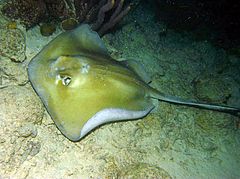- Whiptail stingray
-
Whiptail stingrays
Temporal range: Late Cretaceous–Recent[1]
Southern stingray (Dasyatis americana) Scientific classification Kingdom: Animalia Phylum: Chordata Class: Chondrichthyes Subclass: Elasmobranchii Order: Myliobatiformes Family: Dasyatidae
D. S. Jordan, 1888The whiptail stingrays are a family, Dasyatidae, of rays in the order Myliobatiformes. They are found worldwide in tropical to temperate marine waters, and a number of species have also penetrated into fresh water in North America, Africa, Asia, and Australia. Members of this family have flattened pectoral fin discs that range from oval to diamond-like in shape. Their common name comes from their whip-like tails, which are much longer than the disc and lack dorsal and caudal fins. All whiptail stingrays, except the porcupine ray (Urogymnus asperrimus), have one or more venomous stings near the base of the tail, which is used in defense. They range in size from 18 cm (7.1 in) to almost 2 m (6.6 ft) across.
Genera
- Dasyatis Rafinesque, 1810
- Himantura J. P. Müller and Henle, 1837
- Makararaja T. R. Roberts, 2007
- Neotrygon Castenau, 1873
- Pastinachus Rüppell, 1829
- Pteroplatytrygon Fowler, 1910
- Taeniura J. P. Müller and Henle, 1837
- Urogymnus J. P. Müller and Henle, 1837
See also
References
- ^ Froese, Rainer, and Daniel Pauly, eds. (2011). "Dasyatidae" in FishBase. February 2011 version.

This Chondrichthyes-related article is a stub. You can help Wikipedia by expanding it.
